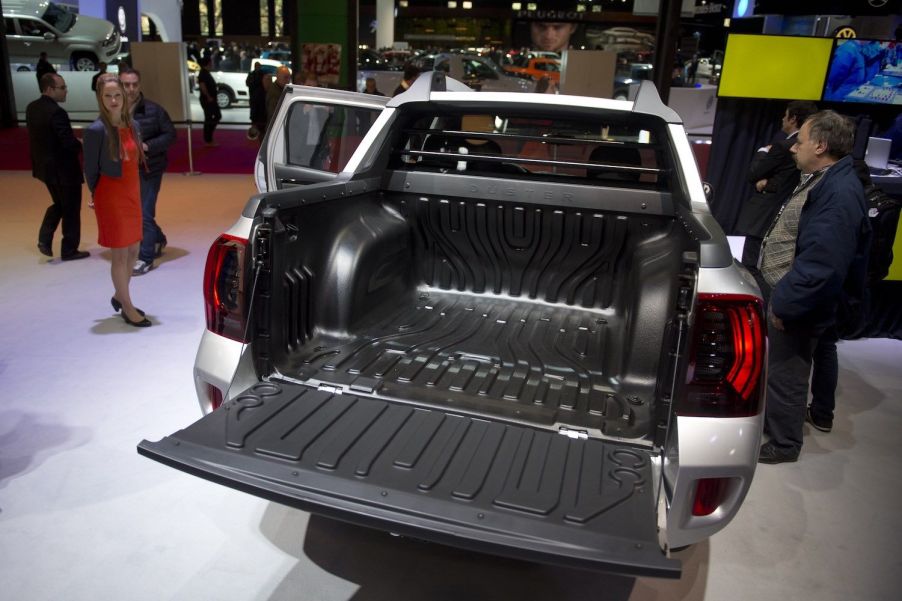
Meet the Oroch: A South American Pickup Truck Built by a French Company, Named After a Forgotten Tribe, and Based on the Nissan Cube
So there I was, walking down the street in Medellin, Colombia, when what did I spot? A compact pickup truck with a nameplate I didn’t recognize: “Oroch.” It was a Renault Oroch, to be precise. And the facts of its history might be stranger than fiction.
The Oroch began life as a Renault Duster option
First, a bit of backstory. Renault and Nissan have a close relationship, but its complicated. Instead of a merger or a buyout, the two automakers entered an “alliance” in 1999. The idea was that by owning stock in one another, they would work together while retaining their separate identities. The result has been a hostile takeover by the French government and the arrest of the CEO by the Japanese government. But now they have both promised to play nice.

In 2002, Nissan kindly engineered a chassis called the “B Platform” that both automakers could use for cars and crossovers–based on the Nissan Cube. One of Renault’s most successful crossovers rides on a stretched version of this platform: the Duster. Since 2010, drivers across Latin America, Asia, Africa, and Europe have been buying Dusters–badged as either Renaults or its Romanian-based subsidiary Dacia. It was so popular in Brazil, Renault Brazil began cooking up a truck version for the 2015 model year: the Oroch.
So what is a Renault Duster Oroch?
The Renault Duster Oroch was a four-door compact pickup truck based on an even longer Nissan Cube chassis. It was stretched six inches more than the regular Duster to make room for a 4.5-foot bed. It debuted in Brazil with a 1.6 or 2.0-liter I4 engine and a manual transmission at the end of 2015. At the beginning of 2016, the automaker added an automatic transmission option. The Oroch is a front-wheel-drive.

Today, the unibody compact truck is popular across south America. It is assembled in either Brazil or Envigado, Colombia. In early 2022, Renault upgraded most aspects of the FWD truck. It now has a more powerful 1.6-liter I4 or a turbocharged 1.3-liter.
At the same time, Renault decided the Oroch could step out of the Duster’s shadow and shortened its name to the Renault Oroch. But what does that even mean?
The Oroch may be named after a nearly forgotten tribe
When I first saw the name, I immediately thought of the extinct “Auroch” bull that is the prehistoric predecessor of modern cows. I wondered if this was just the Spanish spelling. And even though Renault actually had the compact truck hauling a cow in its early advertisements, I was wrong about the name.

The only known meaning of the word Oroch is the name of a tribe in the far eastern parts of Russia. Their religion is a unique mix of the Russian Orthodox Church, Buddhism, and Shamanism. Because they have no written language, their language is on the verge of extinction. The Russian government did try to create a sort of tribal reservation for the Orochs in the 1930s, but has apparently shut it down due to a lack of population. As of the 2010 census, Russia reported there were only 596 Orochs left. But the good news is there are still 596 more Orochs in the world than Aurochs.
Does the Oroch tribe seem like a ridiculous–or even disrespectful–namesake for a compact truck built in South America? Perhaps. But it is no more of a stretch than Volkswagen naming a model after the desert-dwelling Saharan tribe called the Touareg. Or, while we’re on the subject: the Cherokee, Comanche, Chevy Apache, Chevy Cheyenne, Mazda Navajo. What about the entire Pontiac brand with its “Super Chief,” “Star Chief,” “Chieftan,” and “Aztek” vehicles. And what about the Winnebago? Or the Indian Scout motorcycle? Even the words Dakota, Pontiac, and Taos were tribe names long before they were vehicles. But we’ll save that for another article.
So there you have it, the strange but true story behind the compact truck I spotted in Colombia: the Renault Duster Oroch.
Next, learn all about the shocking number of cars named after tribes or see the Oroch pickup truck tested in the video below:




